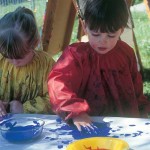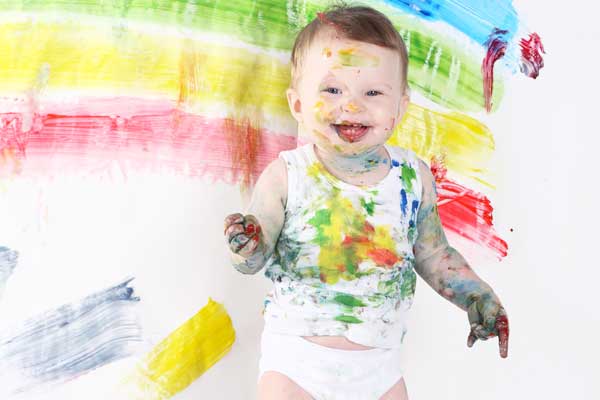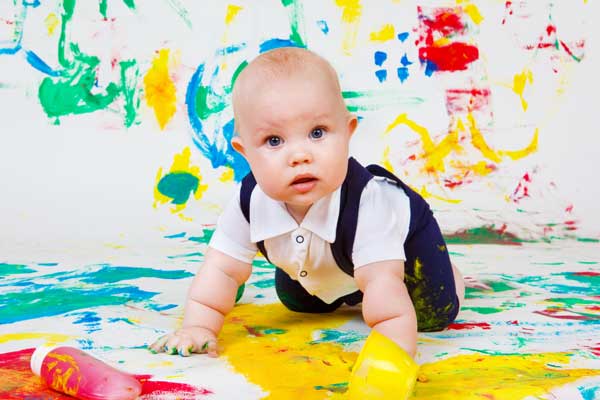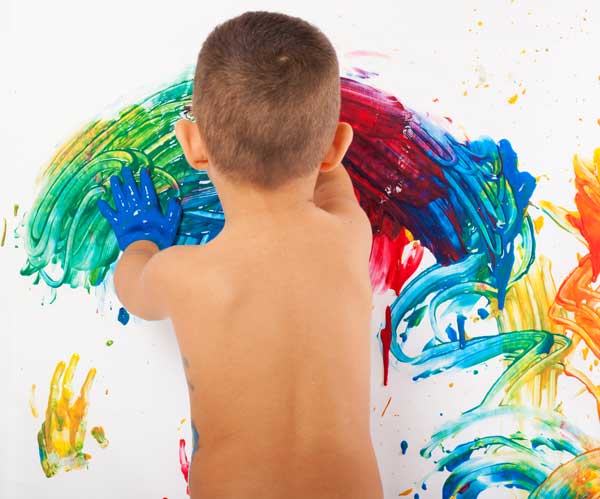Join the thousands of parents already raising smarter, happier babies with our online baby classes: The Active Babies Smart Kids series. Click here.
GymbaROO-KindyROO kids are excelling academically, emotionally, in leadership roles and on the sporting field. Find us at: GymbaROO-KindyROO
Finger painting can be started a lot younger than you may think. Even little babies can join in the fun as it makes a great tummy time activity! There are many good reasons to for you and your little ones to explore this fabulous, messy, art experience.
Not only is finger painting loads of fun, it is also an excellent feeling (kinaesthetic) experience and is fantastic for the development of all the big and small muscles in your growing child’s fingers, arms, shoulders, neck and back. Finger painting is wonderful for the development of colour recognition, experimenting with colours and colour mixing and is terrific for developing creativity skills and simple cause and effect thinking skills.
Yes, it’s messy! However messy play for babies and toddlers is actually crucial to healthy sensory development. These ‘messy moments’ provide important foundation building blocks, sensory experiences, muscle and brain growth – all of which prepares them for later success and learning.
By ensuring finger painting is done in an area that is easily cleaned, with the right type of non-toxic paint and appropriate clothing (or lack thereof!), the benefits definitely out weigh the clean-up effort!
Here are a few ideas from GymabROO-KindyROO to introduce your babies and toddlers to the wonderful world of finger painting and how to help your budding artist to derive the full psychological value from this marvellous medium.
The finger paint
Any finger paint that you use for babies and children must be non-toxic by mouth and non-irritating to the skin. There are lots of recipes and ideas for edible and non-toxic finger paint. We have included a few of our favourites below. Whichever paint you use, finger paint works best if it is thick – similar to the consistency of set custard.
We suggest to only use red, blue and yellow. Your child will make the other colours as these primary colours are mixed. Just place large dobs of the paint in the middle of the surface your little one is using.
To Prepare: Have basins or buckets of clean water to dip hands into before starting. Wetting the hands first makes the paint feel even better. Have hoses (if outside), sponges and towels ready to wipe up afterwards.
Clothing: If warm enough, the less clothing the better. Just a nappy will do! This is not only easier for cleaning and washing, this also allows for more freedom of movement. Where more clothing is necessary, have your child adequately protected in old clothing or an art shirt, with lose fitting clothing underneath. Make sure sleeves are rolled up.
Tips for finger painting with your baby or toddler
- Finger painting is a fantastic tummy time activity for babies. For babies who have not yet been introduced to other foods, you can introduce finger painting, mess free, by placing some finger paint inside a large, sealed, zip lock bag. Place the bag on the floor in front of your baby so he can push on, squish and mix the paint around inside.
 If your baby isn’t yet reaching out, use a rolled up towel or cushion under his chest to free his hands for playing. Keep an eye out for signs of tiring and be ready to change his position.
If your baby isn’t yet reaching out, use a rolled up towel or cushion under his chest to free his hands for playing. Keep an eye out for signs of tiring and be ready to change his position.- Once your baby is eating other foods, enjoy the mess of edible finger paint.
- Finger painting in the bathtub with your little one wearing just a nappy works well, though stay very close, as it can get slippery. Put some paint on the side or floor of the tub and let them at it! When finished, take the nappy off and have a colour bath followed by a wash off.
- Finger painting is a great activity for outdoors. All you need is a large, smooth surface that can be easily wiped down. A white surface is best as this allows the paint to show it’s true colours. You can use plastic sheeting (or a tarp) on the ground or floor. Stiff white plastic or Laminex can be used many times over.
 For those babies who are sitting independently, finger painting can also be done in the high chair. Put your plastic sheeting underneath!
For those babies who are sitting independently, finger painting can also be done in the high chair. Put your plastic sheeting underneath!- Leave finger painting on paper for now. Paper will just get in the way and is much more likely to be eaten or gradually mushed up and integrated into the artwork than to serve any other purpose.
 Once your child is standing independently and confidently, finger painting is best done standing at a table which is about hip height. This encourages free, rhythmic, muscular movements from the shoulders and back. The bigger the table the better, as it allows for larger movements of the arms and hands.
Once your child is standing independently and confidently, finger painting is best done standing at a table which is about hip height. This encourages free, rhythmic, muscular movements from the shoulders and back. The bigger the table the better, as it allows for larger movements of the arms and hands.- Children will also enjoy sponging or washing the paint off and starting again.
 Standing upright at a large surface such as a window or mirror is another excellent way to finger paint. Think of all those gross and fine motor muscles your little one is developing as he works his creative magic in this position. Simply wash down the window with a hose afterwards. Obviously exercise extreme caution when your child is using any glass or mirrored surface.
Standing upright at a large surface such as a window or mirror is another excellent way to finger paint. Think of all those gross and fine motor muscles your little one is developing as he works his creative magic in this position. Simply wash down the window with a hose afterwards. Obviously exercise extreme caution when your child is using any glass or mirrored surface.
Keeping copies of the artworks
If you would like to save a print of any masterpieces created, whether on the floor, high chair, window or table, you will need to be quick and have paper ready. Absorbent paper, such as butcher’s paper, is best. While the paint is still wet, lay the paper on top of the artwork, press firmly with your hands all over, peel off and hang up to dry. Note: edible finger paint will not produce pictures you can keep.
So, all in all not a bad idea to get in the mood for mess and give this fabulous activity for your little ones a go!
Simple, edible finger paint recipes for little babies
Simply mix rice cereal with water until the consistency is thick enough to resemble finger paint, add a few drops of natural food colouring and mix.
You can also use cooked foods to colour the paint, for example: blueberries, carrots, beetroots and butternut pumpkin.
You can simply use yoghurt and a few drops of natural food colouring!
Note: If your baby is allergic or intolerant to any food substances, do not use that food to make finger paint.
Recipe for non-toxic finger paint
You will need: Saucepan, wooden spoon and screw top jars, (though the paint will not keep long).
Ingredients: 12 level tablespoons of cornflour, 1 cup cold water, boiling water, natural food colouring.
Procedure
- In the saucepan, mix cornflour with 1 cup of cold water to make a smooth paste.
- Add sufficient boiling water to bring the whole to 1 litre, stirring to prevent lumps.
- Cook over low heat until mixture begins to boil and becomes clear and thick.
- Divide and pour into jars.
- Add natural food colouring or natural powdered dyes to colour and mix.
- Allow to cool.
Bindy Cummings is a teacher, GymbaROO early childhood neurodevelopmental consultant and early childhood development lecturer. She is the Editor of GymbaROO’s ‘First Steps’ magazine. More on Bindy Cummings here.
Active Babies Smart Kids – Online Baby Classes
GymbaROO-KindyROO’s online series of baby classes is taking the parenting world by storm! It is highly recommended by doctors, paediatricians, early childhood experts and the Maternal Child and Family Health Nurses Association. This series is being called: “The essential guide for parents”. Join the thousands of parents already playing with their babies from birth, in the best way for brain and body development and laying crucial foundations for future learning. What happens in the first year, not only matters, it matters a lot! Introductory video below.
Active Babies Smart Kids online series – Click here.
Try the first class FREE! Click here to watch our Active Babies Smart Kids Episode 1 – Tummy Time
GymbaROO-KindyROO
Thousands of parents, babies and children are presently involved in our programs and creating rising stars. GymbaROO-KindyROO kids are excelling academically, emotionally, in leadership roles and on the sporting field. Come join all the fun and learning! “GymbaROO – The best decision I ever made for my child.” Classes from 6 weeks old – 7 years GymbaROO KindyROO
Enjoy the following GymbaROO-KindyROO articles
GymbaROO-KindyROO: Who, what, where, why and how
All about GymbaROO-KindyROO’s online baby classes for parents and babies: Active Babies Smart Kids
How to raise a smarter, happier baby
Why active babies make smart kids
Become a GymbaROO-KindyROO franchisee
Sliding into learning: Why slides and ladders are great for development.
He May Not ‘Grow Out of It’. A Checklist for Parents of 0 – 5 Year Olds.
Why GymbaROO kids excel at the three R’s – wRiting, Reading, aRithmetic (maths).
Toilet Training. When, why and how.
Why every young child needs a trapeze and how to make one.
Click here for more GymbaROO-KindyROO article choices



